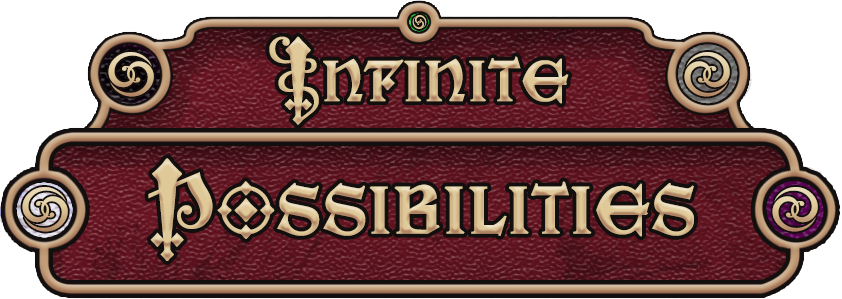Hiya folks! I’m Owen K.C. Stephens, current ttRPG freelancer writer, developer, and designer, and small-scale publisher. I’m here to talk about the two new Community Content Programs from Paizo Publishing – Pathfinder Infinite and Starfinder Infinite – and why you should care about them.
Community Content Programs (CCPs) are opportunities for fans and creators to produce material using the trademarks and intellectual property of a game company. It’s different from the Open Game License (OGL) in lots of ways, not the least of which is not every CCP is for a game with OGL material available. (Also, the Infinite programs, like many CCP, only allows publication on a specific online venue run by OneBookShelf, the people behind DriveThruRPG, but we’ll get to that in a minute.)
But since Starfinder and both editions of Pathfinder do have OGL versions available for people to build from, modify, and ever re-release whole cloth, why should anyone be excited about a Paizo CCP?
In a word, Golarion. Well, and the Pact Worlds.
Product Identity
The OGL allows publishers to declare “Product Identity (PI), which cannot be referenced, derived from, or mentioned in OGL publications by other publishers. The OGL itself says any “product and product line names, logos and identifying marks including trade dress; artifacts; creatures characters; stories, storylines, plots, thematic elements, dialogue, incidents, language, artwork, symbols, designs, depictions, likenesses, formats, poses, concepts, themes and graphic, photographic and other visual or audio representations; names and descriptions of characters, spells, enchantments, personalities, teams, personas, likenesses and special abilities; places, locations, environments, creatures, equipment, magical or supernatural abilities or effects, logos, symbols, or graphic designs; and any other trademark or registered trademark” are automatically PI unless stated otherwise. Paizo, quite reasonably, has also declared all proper nouns and words derived from proper nouns are IP.
Now that doesn’t cover everything. For example, Paizo doesn’t capitalize “vesk,” the lizardlike species from Starfinder, so not only are the game rules for a vesk fair game for OGL products, so is the name of the species itself. But their homeworld, Vesk Prime, and their empire, the Veskarium? Those are off-limits.
So is Absalom, Golarion, the Pact Worlds, Aroden, Pharasma, the Reign of Winter adventure path, Cheliax, Druma, the Pathfinder Society, the Starfinder Society, Old Mage Jatembe, Lord Gyr of Gixx, … basically every interesting person, place, and thing that makes up the campaign settings and adventures of Pathfinder and Starfinder. Someone outside Paizo can use the OGL to write an adventure about a megadungeon in a tower outside a big city, but they can’t have the adventure be in the mile-high Spire of Nex, a siege castle ten miles outside of Absalom.
And, of course, that means the OGL doesn’t cover fiction set in Paizo’s worlds at all.
That means that with just the OGL, there are stories, ideas, and expansions that just can’t be made by anyone other than Paizo. The Pathfinder Compatibility License and Starfinder Compatibility License ease restrictions a tiny but crucial bit, allowing some game books to be mentioned by name and compatibility the with core games to be indicated, but they do nothing to open up narrative elements.
Enter Pathfinder Infinite and Starfinder Infinite
As Community Content Programs, Pathfinder Infinite and Starfinder Infinite open up new possibilities. These allow fans and professional creators alike to use all the juicy proper nouns and the campaign content they represent in products released through the rules and agreements at pathfidnerinfinite.com, and starfinderinfinite.com. There are rules and restrictions, of course, but for you a consumer, those don’t really matter. What matters to you is that there is about to be a lot more material designed specifically for the worlds you are already playing in—including new fiction.
While it’s not going to be anymore “official” than material published under the OGL to work with Paizo’s games, the things produced for the Infinite programs will be set within the existing framework of Golarion and the Pact Worlds (and beyond). You won’t have to try to guess where to put an adventure written in a mile-high tower built by an ancient wizard when you buy a Spire of Nex product on infinite, because the creators will be allowed to actually use the specific elements of the campaign world to give location, context, and history of the new options they give you.
That means not only is there a new set of tools in the toolbox of independent creators, those additional tools let them do more of the work of placing their creations in the worlds you are already playing with. It also serves as an opportunity for people who have no interest in creating independent worlds for their game creations to place products firmly in well-established worlds without having to do all the worldbuilding themselves. That’s likely to bring in new creators we might otherwise never have gotten to hear from, and expand the diversity of offerings in ways that Paizo couldn’t even if they publish twice as many books, and OGL-only publishers can’t.
And, even if you do your own homebrew campaign and don’t care anything about Paizo’s IP, the Infinite programs give creators more opportunities for an expanded audience, new inspirations, and a reason to try new things. Innovation and new competition within the RPG space generally leads to more and better products, which increases the chances that exactly the product you want to buy will be made by someone.
No one knows yet what the big hits of the Infinite programs will be. But we know there will be some, and many of them would not exist without this new possibility.0
Owen K.C. Stephens
Publisher, Rogue Genius Games
Pathfinder/Starfinder freelance contributor





